
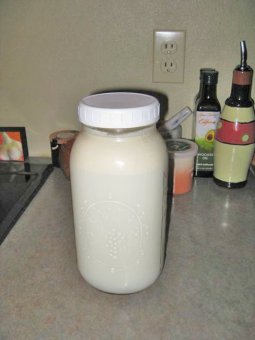 The Second in a Three Part Series about Kefir Grains
The Second in a Three Part Series about Kefir Grains
Many readers contributed knowledge, but two of them, in particular, sent us pictures of the entire process they use to grow their grains:
Growing the Grains:
I just add the grains (about two tablespoons) to1/2 gallon of fresh milk (I usually skim the cream off the top first and make creme fraiche, then butter!) and place the jar in a warm spot-my water heater closet works perfect at a constant 75 degrees. I leave it overnight and strain the grains out in the morning or put it in the fridge and strain it when I have time later. The straining is the most difficult part of the process, but all that is required is a stainless steel strainer, a bowl and a little shaking. Then I whizz with the hand blender for super creamy texture.
Whole raw milk to start:
Skim off the cream (or not):
The kefir grains:
Slip grains into the milk:
Give a little shake:
Put in a warm place:
After about 12 hours at 75 degrees, milk has fermented into kefir:
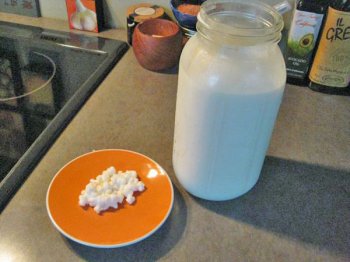 Strain the kefir:
Strain the kefir:
Thick kefir curds:
Save the grains:
Strained kefir is a bit rough:
Hand blend for smooth creamy kefir:
Drink a big glass!
Gene G., Florida
I bought some kefir grains (kefir bacteria colonies that look and feel like little rubbery curds) and have been making it every day for several months now. At first, I wasn’t sure if the grains were as healthy as they should be because they never seemed to multiply. Now, however, the kefir grains are multiplying quite rapidly. So much so that I have to give some away to others who can then start their own kefir cultures or I just eat them.
You can also freeze dry them for a back up if necessary. For me, kefir grains are definitely the way to go–they are self-contained colonies of bacteria that love either raw goat or cow’s milk, and will also work with pasteurized milk.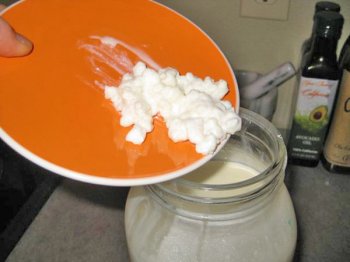 Every morning I strain the grains out of the batch of kefir made the day before, place them in a new Mason jar of milk and let them do their thing overnight.
Every morning I strain the grains out of the batch of kefir made the day before, place them in a new Mason jar of milk and let them do their thing overnight.
If you have too much kefir, just put the jar of milk/kefir grains in the fridge for up to a week or so to slow them down. Then, take them out and proceed as normal when you’re ready to make more kefir. If taken care of they should last indefinitely.
Here are the pictures from this morning’s kefir grain (kefir bacteria colonies) feeding. As has often been noted kefir “grains” is misleading but that’s the word we seem to be stuck with. There is no “grain” involved, rather these rubbery little things are actually living colonies of bacteria.
Here’s the milk after 24 hours with the kefir grains.
Note how thick the milk has become:
Stir it up good to allow it to go through the strainer better:
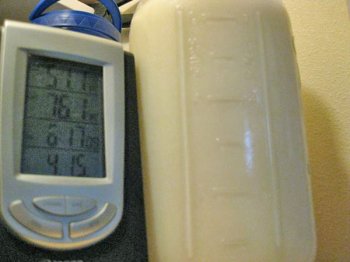
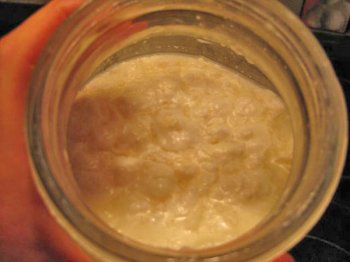
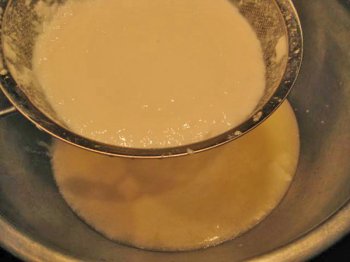
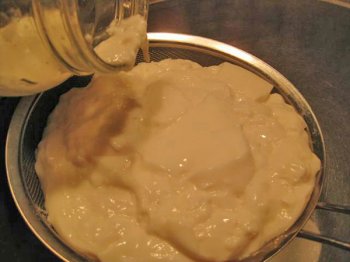
YOU MIGHT ALSO LIKE



 Saturated fat is fat that consists of triglycerides containing only saturated fatty acids. Saturated fatty acids have no double bonds between the individual carbon atoms of the fatty acid chain. That is, the chain of carbon atoms is fully "saturated" with hydrogen...
Saturated fat is fat that consists of triglycerides containing only saturated fatty acids. Saturated fatty acids have no double bonds between the individual carbon atoms of the fatty acid chain. That is, the chain of carbon atoms is fully "saturated" with hydrogen...








